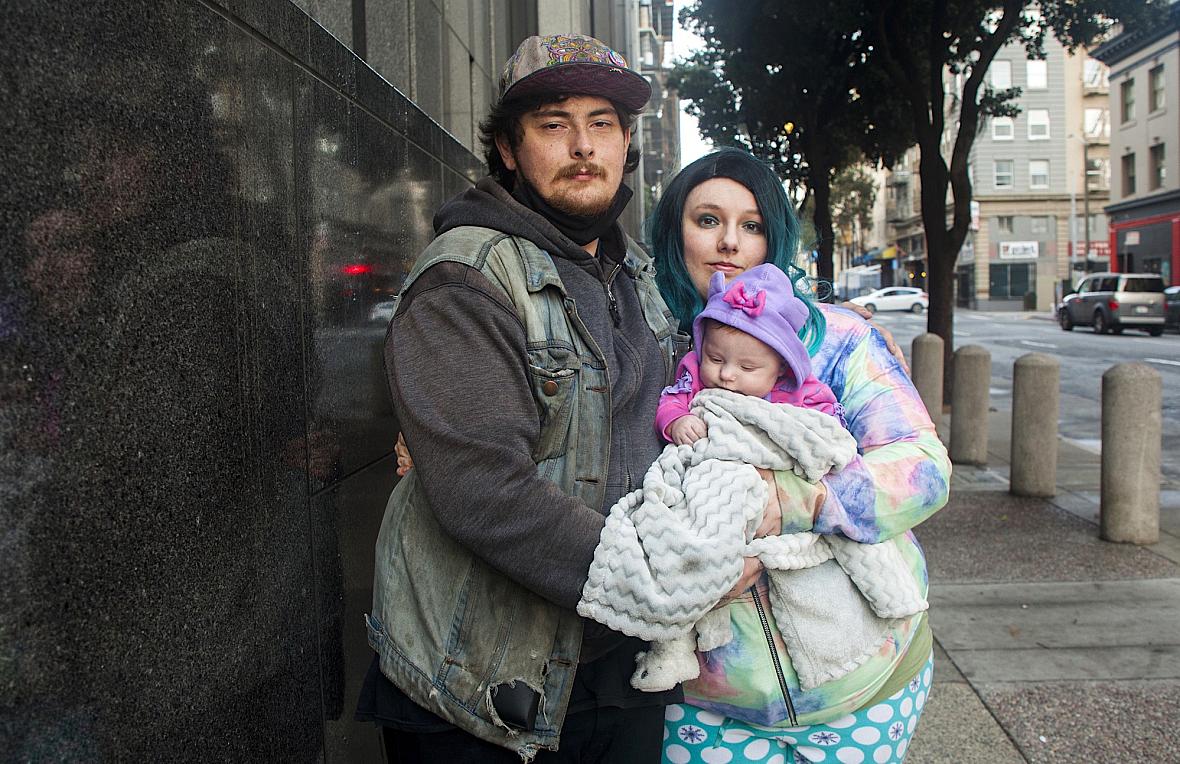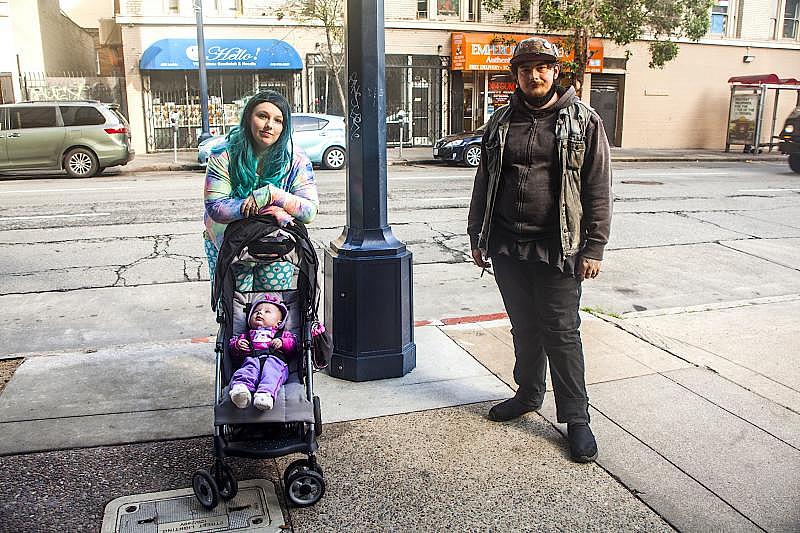Part 1: A homeless family in SF lives in housing limbo, while more city-funded apartments sit empty
This story by Kristi Coale, a 2020 Impact Fellow, is part of a larger project investigating San Francisco’s record of caring for its unhoused people during the pandemic.
Her other stories include:
Part 2: For SF’s Homeless, A Permanent Home Is the Ultimate Goal. The Fight Is How to Get There
Part 3: SF’s Homelessness Department Has a Billion Dollars, and Brings Up Almost as Many Questions
Building Homes for SF’s Homeless Is Hard. Providing Mental Health Care Is Even Harder
SF’s Big Street Count Is Coming Back, But Homelessness Fixes Require Deeper Reform

Nathan Caine, Cimber Sims, and their baby Nova are living in a shelter in the Tenderloin and received approval for permanent city-sponsored housing months ago. They are still waiting to move, while nearly 10 percent of the city’s supportive housing units remain vacant.
(Photo: Pamela Gentile)
This week is full of major life events for one San Francisco family: The grown-ups are getting married, and it’s time to celebrate their daughter’s five-month “birthday.” As Nathan Caine and his fiancé Cimber Sims push their infant Nova in a stroller through the Tenderloin, they say they’re grateful for what they have. They’ll prepare food for the nuptials in the shared kitchen of their homeless shelter, which is the first real roof they’ve had over their heads in more than a year.
“Being in the shelter has really helped us out,” Caine says, and Compass Family Services, their service provider, is “doing everything it can.” Still, they can’t wait to move into their own place. That’s where their story turns to frustration. It’s also reflective of the difficulties San Francisco faces helping its unhoused residents, which had been a crisis well before COVID-19 struck.
Caine and Sims have what many unhoused San Franciscans covet: paperwork from the city’s homelessness department showing they’re ready for supportive housing. However, they’ve hit a roadblock: Their child isn’t old enough. “A lot of the family housing options are predominantly looking for people with children of school age,” Caine says.
Before Compass, the two were living in vehicles on the streets. Caine, 28, who has bipolar disorder and autism, says he’s been homeless off and on since he was 14. The pandemic has been hard on the couple; Caine says he has supported himself as a musician since his mid-teens. Now that there are no live gigs, that livelihood is gone.
Moving folks like Caine and Sims into stable living situations with access to healthcare and other services is the cornerstone of SF’s homelessness strategy. But of the city’s nearly 8,000 permanent supportive housing units, 766 — almost 10 percent — are sitting empty, more than three times the limit that the city’s Homelessness and Supportive Housing Department, or HSH, agreed to honor in 2019.
Doug Gary, co-director of supportive housing provider DISH, says he has 34 vacancies across DISH’s eight properties. Some are recent vacancies, but many have sat empty for weeks. Swords to Ploughshares, which houses veterans on Treasure Island and elsewhere, has had 52 vacancies, most of them for more than a month.
The glacial pace of progress feeds into the well-trod narrative of sclerotic, decades-old City Hall bureaucracy. Nevertheless HSH is all of four years old, created specifically to use information technology to more efficiently match unhoused people with shelter and services.
Caine, Sims, and their daughter are among the hundreds of people whose data is in HSH’s system and now have documentation saying they’re ready for housing.
“Because of our collective failure, there’s [more than] 700 units empty tonight, more than 700 people on the streets needing housing in the middle of a public health crisis, and it’s a huge waste of money because someone, somehow is paying for empty housing units,” says Gary.
With a new billion-dollar budget for HSH, and potentially millions of dollars more coming from the federal government, the pressure is on for a troubled department in a city with a high-profile housing shortage.
A growing problem
The 766 vacancies, first reported last week in the San Francisco Public Press, represent a 58 percent jump in six months. The numbers are not an anomaly.
Service providers like Gary and officials like Sup. Matt Haney have been urging a fix for months. Instead, it has gotten worse. In a Board of Supervisors committee hearing last September, HSH officials put the number of vacancies at 484. (The problem didn’t begin with the chaos of the pandemic. A critical report on HSH, released last year, noted that in 2019 there were 250 vacancies.)
Why has the vacancy rate gotten worse? “I don’t exactly know,” Haney tells The Frisc. Yet there are several reasons. At the September committee hearing, HSH acting director Abigail Stewart-Kahn stated that, despite the department relying on a computerized system, an employee must check that every unit and potential resident are correctly matched to account for issues such as wheelchair access or suitability for children.
Having an infant makes it harder to find appropriate city-supported permanent housing. That’s what Cimber Sims and Nathan Caine have heard from city officials. (Photo: Pamela Gentile)
At the time, Stewart-Kahn said that the city’s data system, which was set up to track people like Caine and Sims and prioritize them for housing and services, was not designed to keep track of available housing units. (The system, called Online Navigation and Entry, or ONE, launched in 2018.) Lacking other choices, officials have tried to use it anyway, and now vacancies have mushroomed to nearly 10 percent of the city’s inventory.
Two weeks ago, at the latest meeting of the Local Homelessness Coordinating Board, HSH director of housing Salvador Menjivar offered more explanations for the vacancies, including general maintenance, cleaning, and other situations that were never fully explained—among them a unit being “temporarily occupied.”
Haney says HSH has told him some people in the emergency “shelter-in-place” hotels, which the city rented after COVID struck, are turning down supportive housing even though they have first priority. He’s also been told there were issues with the technology and the referral process. “These may be true in a small number of cases, but I don’t think they account for so many vacancies,” Haney adds.
The District 6 supervisor, who has pushed for more oversight of HSH since 2019, sent a letter last week to Stewart-Kahn asking for more answers. Most vexing for Haney is that people in the hotels are experiencing delays: “These people were not on the street, they were in our system because they were moved from shelters and Navigation Centers. I assumed the process would be more streamlined because of this.”
In response to multiple queries from The Frisc, HSH spokesperson Deborah Bouck emailed this statement: “It is critical that every resource we have available is utilized to end homelessness for people in our community. We are working diligently internally and with our nonprofit partners to improve our housing placement process, expedite placement, and reduce vacancies.” (The Frisc also reached out to the mayor’s office but has not yet received a response.)
Looking for oversight
Another problem is a sudden shift in priorities triggered by the pandemic. The 1,810 unhoused people in the shelter-in-place hotels now get first dibs at permanent supportive housing — in effect jumping the line ahead of the several hundred people who were on the list before COVID, according to frustrated providers and advocates who penned a letter to the mayor in late January.
In December, the Board of Supervisors passed legislation extending the hotel program and also requiring the city to move people who had stabilized from hotels into supportive housing, along with backfilling six rooms for every 10 vacated.
Next week, the supervisors will consider an ordinance that expands the hotel program by 500 rooms, thanks to increased federal funding. But the larger issue of HSH oversight and accountability remains an elephant in the room.
Haney — whose district includes the Tenderloin and South of Market neighborhoods and consistently has had SF’s highest incidences of homelessness — proposed a 2019 ballot measure to create a formal oversight commission, much like the Planning and Police commissions. (HSH is the only major city department that reports directly to the mayor without a commission.)
Mayor London Breed rebuffed this, saying the proposal would only impede the department’s efforts, and Haney couldn’t muster enough support from other supervisors to place the plan for an oversight commission on the ballot. Instead, the mayor convened a working group, whose meetings were not open to the public. It met throughout 2019 but stopped due to the pandemic.
That has left the Local Homelessness Coordinating Board, which has no formal authority, as the only public venue other than occasional supervisors’ hearings for scrutiny of HSH. (It’s where the latest troubling vacancy numbers emerged earlier this month.)
The coordinating board checks on HSH’s expenditure of federal dollars, but otherwise “there’s not a real oversight relationship,” says board co-chair Del Seymour. “Stewart-Kahn checks in with us more than she’s mandated to. It’s more of a courtesy.”
This thicket of proposals, paperwork, and departmental procedures are cold comfort for Nathan Caine, Cimber Sims, and 5-month-old Nova, who arrived right when her parents received their housing referral. They’re still waiting to move.
Typically a family like theirs could only stay at the shelter for six months. But the pandemic has brought a reprieve; Compass will let them stay until they have their city-funded apartment. Unfortunately, no one knows when that will be.
Kristi Coale (@unazurda) is a San Francisco-based freelance writer and radio producer for various outlets, including KALW’s Crosscurrents and the National Radio Project’s Making Contact. She reported this story as a USC Annenberg Center for Health Journalism 2020 Impact Fund Fellow.
[This story was originally published by The Frisc.]
Did you like this story? Your support means a lot! Your tax-deductible donation will advance our mission of supporting journalism as a catalyst for change.
